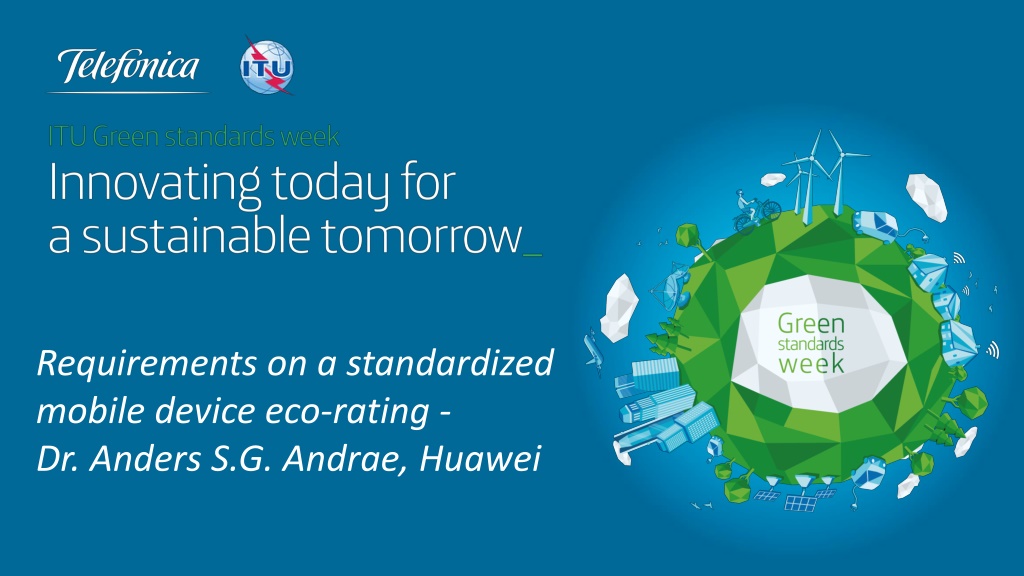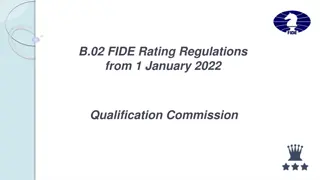Greening Mobile Devices: Requirements for Standardized Eco-Rating
The article discusses the importance of eco-friendly practices in mobile device manufacturing and disposal. It highlights the environmental impact of mobile phone scrap, emphasizing the need for standardized eco-ratings. Dr. Anders S.G. Andrae from Huawei provides insights on criteria for eco-rating, electricity consumption in devices, and differences between eco-rating and Life Cycle Assessment (LCA). Recommended criteria for ITU-T on Eco-Rating and challenges in responsible design are also addressed.
Download Presentation

Please find below an Image/Link to download the presentation.
The content on the website is provided AS IS for your information and personal use only. It may not be sold, licensed, or shared on other websites without obtaining consent from the author. Download presentation by click this link. If you encounter any issues during the download, it is possible that the publisher has removed the file from their server.
E N D
Presentation Transcript
www.huawei.com Requirements on a standardized mobile device eco-rating - Dr. Anders S.G. Andrae, Huawei HUAWEI TECHNOLOGIES CO., LTD.
Requirements on a standardized mobile device eco-rating www.huawei.com Author/ Email: Dr. Anders Andrae/anders.andrae@huawei.com HUAWEI TECHNOLOGIES CO., LTD.
The growing importance of greening mobile end-user devices On average 1 ton mobile phone scrap could include 128 kg copper 0.347 kg gold 0.15 kg palladium 3.63 kg silver 15 kg nickel 6 kg lead 1 kg antimony 10 kg tin (from Navazo et al. Forthcoming) 2012 Shipped units (millions) of mobile devices 2012 to 2017 2000 1911 1800 1630 1600 1390 1430 1400 1280 1350 1320 1220 1200 1175 1050 1000 900 800 700 650 511 600 570 500 350 400 284 443 246 384 332 200 250 150 0 2013 2014 2015 2016 2017 Feature, Mid-range, budget phones Smart phones Tablets Laptops In 2014 scrapped mobile phones, smartphones, and tablets could add 0.234 million tonnes scrap. Annual global municipal solid waste generation is Adapted from Andrae, A.S.G, & Corcoran, P. M. (2013). Emerging Trends in Electricity Consumption for Consumer ICT. 1.3 billion tonnes. 3 HUAWEI TECHNOLOGIES CO., LTD.
Perspective on Device electricity (TWhrs) in 2012 25000 23192 20000 3 % of ICT 15000 Use 10000 854 5000 1489 Manufact uring 67 2 244 23 335 9 27 5 2 10 0 Adapted from Andrae, A.S.G, & Corcoran, P. M. (2013). Emerging Trends in Electricity Consumption for Consumer ICT. GeSI SMARTer2020 report from GeSI show similar result. 4 HUAWEI TECHNOLOGIES CO., LTD.
Recommended Criteria for ITU-T on Eco-Rating ERs range from satisfyingly transparent (understandable which input gives a certain output) to black box (not fully clear how the ER works) VDF/TF new eco-rating is a very good basis/concrete tool to finish the Recommendation in 2013 in a unified and transparent manner. Comments on LIFE CYCLE, Basic LCA : More transparency on how CO2e, water, and resources are evaluated. Add Location of Production of Screen, IC, PCB, and type of Screen for more sophistication. Robust criteria from other ER could be added. Use stage scenario not clear. Comments on RESPONSIBLE DESIGN : More options needed for certain questions due to diversity of phones. Usage of Bioplastics should be added as a criterion. Fully separable packaging materials unclear. Pure material stream needs to be defined according to some standard. 5 HUAWEI TECHNOLOGIES CO., LTD.
Issues Current Eco-Rating vs LCA Difference between vendor LCA CO2and Eco-Rating CO2for same model The difference is due to representative data better reflecting the upstream than current Eco- Ratings 100% 80% 60% 40% 20% 0% Full vendor LCA CO2 Eco-Rating CO2 6 HUAWEI TECHNOLOGIES CO., LTD.
Issues Current Eco-Rating CO2vs LCA CO2 Issue 1: Differences between vendors CO2e scores based on LCA and CO2e scores based on locked ER metrics. Current 16 criteria are not enough to describe the life cycle impact of different vendors mobile device models. Add choices which help the vendor to reflect the reality of the upstream and downstream in a better way Issue 2: Difference in CO2e score for same model for different ER Found a 20% difference in CO2e scores for different ER Life Cycle section for the same phone model Spread of problem not investigated 7 HUAWEI TECHNOLOGIES CO., LTD.
Overall issues for vendors Clarity It should be totally clear for individual vendors (manufacturers) how a certain ER is obtained. Transparency E.g. it shall be understood explicitly which CO2e score gives a certain ER for the corresponding Specification (e.g. 40 kg CO2e gives 2.1 for Basic LCA). Validation Clarify how the validation is done for each Specification (e.g. Responsible Design) and Criteria (e.g. Proportion of Pure material stream which can be separated) 8 HUAWEI TECHNOLOGIES CO., LTD.
Requirements & Suggestions Requirements Add LCA elements for further diversification between devices. Any Criterion which cannot be easily validated needs to go. Each operator should make totally clear for individual vendors (manufacturers) how a certain ER is obtained. Suggestions: Fully calculated examples of some imaginary phones will help for black-box oriented ER schemes Analyse further differences between vendors CO2e scores based on full LCA and CO2e scores based on locked ER metrics (e.g. kg CO2e/touch screen area). Analyse further differences between vendors models in between different ERs. 9 HUAWEI TECHNOLOGIES CO., LTD.
Thank you 10 HUAWEI TECHNOLOGIES CO., LTD.























